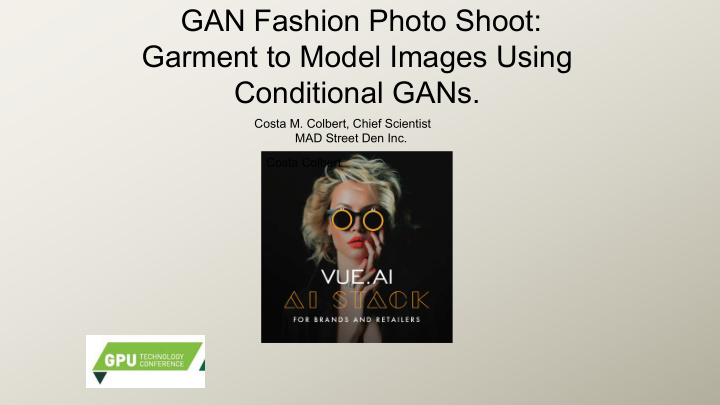



GAN Fashion Photo Shoot: Garment to Model Images Using Conditional GANs. Costa M. Colbert, Chief Scientist MAD Street Den Inc. Costa Colbert
Studies show higher purchase rates when clothing is shown on human figures.
Li Live e model el photogr graphy is expen ensive • Brands and retailers on average spend $100-500 per look. Lower per-look prices do not include hair, makeup, and styling • Shooting capacity is limited • 35-40 looks per day with hair & makeup • 60-70 looks per day without hair & makeup • Bulk of the cost includes: • Models’ time (at least $1,200 day rate) • Photographer’s time • Digital tech & post production Hair, makeup, styling • • Cost does not usually include: • Pulling samples Transporting samples to photo studio • Photo studio & equipment • • Time to cast models & hire photographers & stylists • Time of internal teams involved in a photo shoot process • Reshoots due to items not selling with a current image (3-5% of items)
GA GANs to the e res escue. e... If quality and control of images is sufficient...
GA GANs to the e res escue. e...
GA GANs to the e res escue. e... Garment images Generated images
A few examples… Garment Catalog Generated Generated image photo image image
A few examples… Garment Catalog Generated Generated image photo image image
A few examples… Garment Catalog Generated Generated image photo image image
Varying pose
Gen Gener erative e Adver ersarial Network Training Dataset providing real samples x Samples z from prior distribution e.g. N(0,1) Real / Fake z Discriminator D(x) decides if sample is from x Generator G(z) approximates a sample from x
Also use L1 reconstruction loss term: abs (G(z)-x )
Co Conditional Ge Generative Adversarial Network Training Dataset providing real samples x ~ X Samples z from prior distribution e.g., garments, pose, other labels Real or Fake ? Discriminator CNN D(x, garment) decides if sample is from x, also requiring correct garment Generator CNN G(z) approximates a sample from x
Co Conditional GA GAN - di disc scri rimi mina nator (Patch GAN, Isola et al. Input is Model 2016) Image concatenated to Real/Fake is Garment Image determined by observing Discriminator CNN patches of limited 6 CNN layers extent. Convolution Instance Normalization Dropout
Hmm.., maybe that global discriminator term wasn’t such a bad idea..
Co Conditional GA GAN - ge generator Encoder Decoder Latent Pose Fashion Model Image Vector Garment Image Decoder 6 CNN layers 4x3x512 Encoder 6 CNN layers Deconvolution/Unpool Convolution Dropout Instance Normalization Instance Normalization Adam Optimizer GTX1080ti 2-4 GB
Pose Interpolation
GA GAN gen ener erator - la latent t ve vector Encoder Decoder Latent Vector 512x4x3
la latent t vect ctor or - In Inter erpolation Enc Dec X1 X1 garment LV1 LV2 Enc Dec X2 X2 garment
la latent t vect ctor or - In Inter erpolation Enc Dec X1 X1 garment Dec LV1 X Fi,n F(LV1,LV2) LV2 Enc Dec X2 X2 garment F i,n (x,y) = x + (y-x)*i/n
Latent Variable Interpolation Shoes Neckline Hemline
Latent Variable Interpolation Hemline
Latent Variable Interpolation Color Background Note sleeves.
la latent t vect ctor or – mo modi dify y value ues Enc Dec X1 X1 garment Dec LV1 X F, F(LV1,i) i Latent Vector 512x4x3
Principal Component Analysis (PCA) PCA is a dimension-reduction tool that can reduce a large set of variables to a small set that still contains most of the information in the large set. PCA transforms a number of (possibly) correlated variables into a (smaller) number of uncorrelated variables (principal components). PCA determines the new dimensions on the basis of variance.
Principal Component Analysis (PCA) Use PCA to go from 512x4x3 (~6k) dimensions to 100. LV 6k PCA PCA LV 100 Choose an entry, scale by +/- 10 LV 100 Inv(PCA) LV 6k Dec X F, i
PCA Latent Variable Interpolation Skin color Model build
PCA Latent Variable Interpolation Shoes
Conclusions and Future Work Conditional GAN’s are well-suited for image generation in well-defined domains . Good enough for the casual observer not to notice. GAN’s have many “moving parts,” but we are getting better at using them. More work needed on accessories, choosing specific shoes, handbags, etc. Requires more thought on implementing conditioning labels.
A big thanks to Preferred Networks
Thank you!! l support@madstreetden.com
Recommend
More recommend